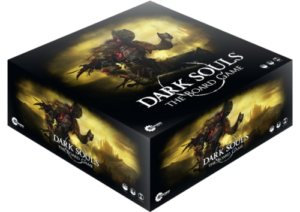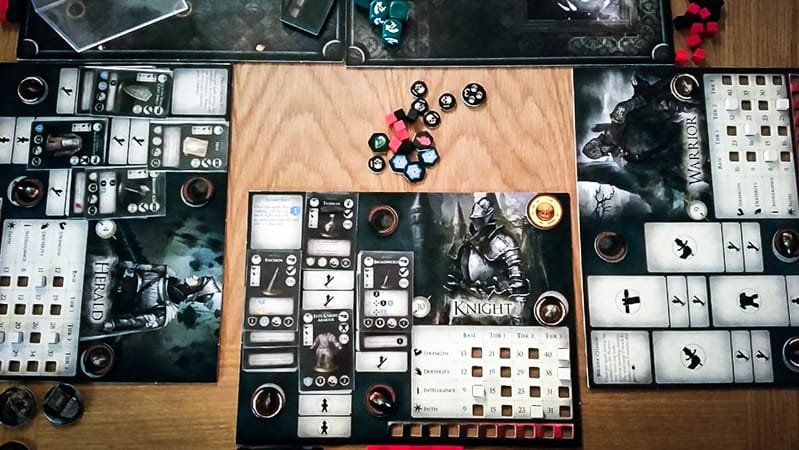Dark Souls: The Board Game Review
Year: 2017 | Players: 1-4 | Minutes: 90+ | Ages: 14+
I had a chance to play this one with some folks outside of my normal group, so this is going to be my personal review rather than my group’s. This Dark Souls: The Board Game review is based on three plays.
What is Dark Souls: The Board Game?
Dark Souls: The Board Game is a cooperative dungeon crawler board game in which you’re trying to move through rooms, fight enemies, and hopefully defeat the final bosses. It is based on the Demon’s Souls, Dark Souls, and Bloodborne series of video games, which means that you can expect it to be a brutal and, hopefully, rewarding experience.
Dark Souls is published by Steamforged Games and designed by created by David Carl, Alex Hall, Mat Hart, and Richard Loxam.
Rules Overview
To begin a game of Dark Souls, everyone will get their own characters, each of which starts with their own player board and starting equipment. You’ll also choose which mini boss and boss you’ll be fighting, which will tell you the encounter cards that will be placed on each tile of the dungeon.
Your home in this game is the bonfire tile. This is where you’ll go when you die or voluntarily “rest.” When you are at the bonfire tile, you can spend souls to buy treasure and level up your characters, allowing you to get better equipment (which you will most definitely need).
Your life is tracked by a shared stamina/health bar on your player board, called the Endurance Bar. You’ll add a cube to the stamina side when you make extra movements, and you’ll add a cube to the health side when you take hits from enemies. If the bar ever fills up, you’ll die and the whole team will go back to the bonfire.
Unlike in the videos games, you have a limited number lives, which you track with the spark dial. Every time you die or choose to rest you’ll lose a spark, bringing you that much closer to losing the game.
When you enter a room, you’ll look at the encounter card to see where to place the enemies, treasure chests, traps, and terrain. This information is always the same throughout the game, so you learn how to deal with it through trial and error.
Moving and fighting in Dark Souls is actually really simple once you understand what all of the icons mean. You can always move one node in any direction, but you can also move more if you don’t mind using some of your character’s stamina. Once you are within range of an enemy, you will roll dice based on the equipment you currently have and see if you have enough attack symbols to defeat the enemies. After a player has taken a turn, all of the enemies activate, and then the next player takes their turn.
If you are able to clear a room/encounter, you’ll gain souls. If you are killed, everyone moves back to the bonfire and all of the encounters reset. Also, just like in the video games, if you die the souls are left in that room rather than going with you to the bonfire.
The mini bosses and final bosses are a bit different than the other enemies in the game. They have their own sets of cards that tell you how they move and attack. You’ll flip one of their cards, execute their actions, and then try to move in to hit them. Each of the cards will tell you where the boss’ weak points are and where they’ll attack. Some cards have the bosses attack from a distance while others can hit multiple characters in a sweeping motion.
If you are able to defeat the big boss, everyone wins! If anyone on your team dies after your spark count reaches zero, you lose.
There is also a campaign mode that plays slightly differently than the basic game. It allows you to play through scenarios and track your progress in the back of the rulebook.
That is a very brief overview on how to play Dark Souls. If you want to see a detailed description of all of the rules, definitely check out the official Dark Souls rulebook (PDF).
Check out Dark Souls: The Board Game at Amazon
Pros and Cons
Pros
- Since I am such a huge Bloodborne fan, the “grinding” nature of this game is probably my favorite thing about it. No, it’s not going to be for everyone, but those who like building up their characters as they learn how to go through each encounter will probably love Dark Souls.
- I am extremely impressed with how well the theme comes through in this game. Not only will fans of the video games recognize some of the popular characters, but most will also love that familiar feeling of dread found in those games.
- Even though there aren’t as many cooperative actions as I thought there’d be, you do have to work as a team if you want to beat this game. One of the reasons why it runs so long (see below) is because you will need to take some time to talk about how to deal with each encounter. This is actually a great thing, in my opinion.
- The miniatures, especially the bosses, are fantastic. You’ll look at those huge boss figures on the board across from your normal-sized characters and you’ll recognize that you have a very tough task ahead of you.
- The bosses also fight very much like they do in the video games. You have to learn their movements to be able to beat them, which could take you a while to figure out.
- The Endurance Bar was a fantastic idea. I love those (very tense) moments where you have to decide whether you should go in for the big attack or go rest to gain some health back.
Cons
- Unsurprisingly, the one area where this board game version of Dark Souls differs from the video games is that it is much more of a puzzle than an adventure game. Sure, you discover new weapons, but for the most part you are just trying to figure out how to “solve” each encounter. No one I played this game with had a problem with that, but I can see how that might bother some gamers who were anticipating a more adventurous feel to the game.
- Dark Souls is a bit longer than it probably should be. You’ll be very lucky to finish any playthrough in less than two hours (ours were closer to 3.5 hours), which could be enough to keep some people from going near this one.
- The rulebook isn’t great. It’s actually not terrible, but I think this is one of those games that absolutely required a “Rules You’ll Forget” section so it wasn’t so confusing during the first couple of plays. Also, the icon reference page on the back of the rulebook only covers some of the icons you’ll come across.
- The tiles aren’t very attractive. I like the nodes idea, but they don’t blend with the overall look of the tiles very well.
Final Thoughts
Dark Souls: The Board Game is definitely not going to be for everyone. Some people will find it too repetitious since you do have to constantly reset the rooms and fight the exact same enemies over and over again. Some people won’t like that it can easily take over two hours to play.
That being said, chances are if you do think you’ll enjoy this game, you probably will.
In my opinion, Dark Souls is a solid dungeon crawler that is true to its source material. While it does run a bit long, I actually love the fact that, like in the video games, it feels fantastic upgrading your characters and absolutely destroying some of the enemies that killed you earlier in the game. It’s a game that I will never play solo (I have Bloodborne for that!), but I will always be happy to play it with other dungeon crawler fans who don’t mind grinding through a very tough game.
Dark Souls: The Board Game Links
BGG | Amazon | Miniature Market
Thanks for taking the time to read our Dark Souls: The Board Game review!
Subscribe to our newsletter if you want more co-op board game content sent right to your inbox!



